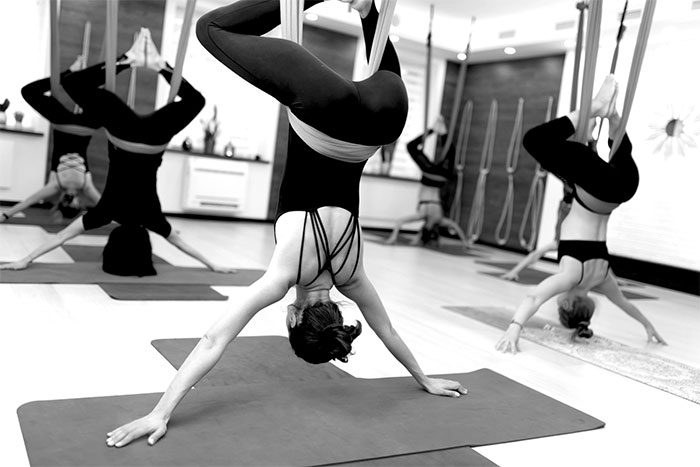In recent years, aerial yoga has become a popular practice among many women, especially those in middle age. Many individuals turn to aerial yoga to enhance their flexibility and to engage in more challenging poses.
So, how does aerial yoga differ from traditional yoga? What important considerations should practitioners keep in mind to avoid injuries and unfortunate accidents? Coach Ngọc Phạm (aerial yoga instructor based in Hanoi) will address these questions in this article.

Aerial yoga is a practice sought after by many women.
What is Aerial Yoga?
Coach Ngọc Phạm shares that aerial yoga is a blend of aerial acrobatics and traditional yoga poses, developed since the early 2000s. Participants practice various exercises using a soft silk hammock suspended about 1 meter off the ground.
“Aerial yoga combines traditional yoga movements with aerial performance art,” Coach Ngọc Phạm explains.
What should you pay attention to in aerial yoga to prevent accidents?
According to Coach Ngọc Phạm, accidents or injuries can occur in any physical activity, not just in aerial yoga classes.
“There are many subjective and objective factors that can lead to injuries, ranging from mild to severe. In some cases, fatalities have occurred during sports activities, both among professionals and amateurs, so it is difficult to pinpoint the exact cause of death without thorough investigation,” Coach Ngọc Phạm adds.

Accidents or injuries can occur in any physical activity, not just in aerial yoga classes.
To ensure the safety of students during practice, instructors must be well-equipped with knowledge about classroom safety, maintain discipline, be serious, and exhibit the right attitude towards the discipline they are teaching. They should not take shortcuts in their teaching merely because it is a trending activity. Furthermore, instructors need to observe attentively to assist students promptly.
In addition, teachers should understand both the advantages and disadvantages of the discipline they are teaching to enhance safety for their students.
For practitioners, it is essential to understand your body, health condition, and fitness level to choose an appropriate discipline.
From a practitioner’s perspective, you should recognize your health status and the purpose for joining the class. Don’t hesitate to interact and share with your instructor for the best support in your practice, helping you avoid unnecessary risks.

Students should confidently interact and share with their instructors to receive effective practice support.
Health Considerations for Practicing Yoga
Coach Ngọc Phạm advises that individuals with specific conditions, such as pregnant women, those with joint issues, spinal surgery, injuries, cardiovascular problems, obesity, diabetes, or glaucoma, should consult with a doctor and their instructor before participating in aerial yoga classes.
The soft silk hammock is the primary equipment used in aerial yoga classes. During practice, participants may transfer part or all of their weight to the hammock, which becomes taut. This tension allows practitioners to stay securely on the fabric. However, the tension also means that the body parts on the hammock will be constricted.
In some cases, students can alleviate discomfort by learning to engage and tighten their muscles with just the right amount of force. For new practitioners, this may not always feel comfortable, so the instructor’s experience is vital in helping students adjust and feel more at ease.
Many poses in aerial yoga require participants to suspend themselves high and secure themselves in the hammock. The instructor’s skill is crucial in guiding students into and out of poses (lowering to the ground) safely. Therefore, students should not practice aerial yoga alone at home without sufficient strength and experience. Additionally, avoiding wearing jewelry during aerial yoga practice is important, as these items can easily get caught in the hammock, posing safety risks to the practitioner.
- People are fascinated by the “snail the size of a button with vibrant colors” but are unaware of the chilling truth behind it.
- What would happen if you inhaled air from the atmospheres of other planets in the Solar System?
- Top 3 inviolable areas of the Forbidden City: The last location that cannot be accessed even when the doors are open!


















































